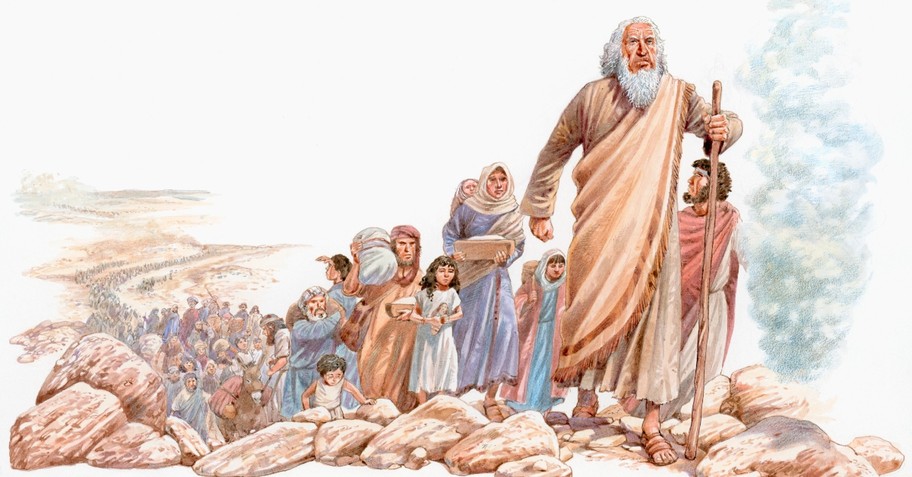5 Things We Learn about God from Moses and the Snake

When you think of snakes do you think of help and healing?
If you’re anything like me you think of destruction, pain, and being really uncomfortable whenever you think of a snake. I don’t like snakes. Yet if you’ve noticed the symbol on an ambulance, or your nurse’s pin, it is two snakes intertwined on a pole? How in the world are snakes supposed to symbolize help and healing?
Originally a single snake wrapped around a pole was the symbol, but in the early 1900s the AMA embraced a symbol from Greco-Roman mythology; namely, the Caduceus. The legend goes that Mercury (the patron saint of thieves and outlaws) tried to stop a fight between two snakes by throwing a rod at them, but rather than stopping the fight they wrapped themselves around the pole. What does that have to do with healing? It was the rod of Aesculapius that was thrown and Aesculapius is the god of healing.
But that single snake on a pole goes further back than Greco-Roman mythology. We see a similar symbol make an appearance in 2 Kings 18:1-4 where we read that the good king Hezekiah “broke into pieces the bronze snake Moses had made, for up to that time the Israelites had been burning incense to it…” To understand more about Moses and the snake, we must turn to Numbers 21:4-9.
Photo Credit: ©GettyImages/JMrocek
What Happened with Moses and the Snake?
In Numbers 21 the people of Israel are traveling through the wilderness to enter into the Promised Land. As per their usual, they took to impatiently grumbling. As it says in verse 5, “the people spoke against God and against Moses.” They were hangry and fell back into wishing they could be back into Egypt with a meal instead of out in the wilderness having to rely upon the Lord’s manna (calling it worthless). As a result, we read that “the LORD sent fiery serpents among the people…” Many died.
The fiery serpents drove the Israelites to repentance (at least a type of repentance) and they pleaded with Moses to ask the LORD to remove the serpents. Moses prayed and God told Moses to “make a fiery serpent and set it on a pole, and everyone who is bitten, when he sees it, shall live.” Moses did exactly as God said and whenever someone was bitten if they looked at the bronze serpent they would live.
But what exactly was happening in this story? Why did God tell Moses to make a serpent? If a serpent is killing you, then why would you use an image of a serpent as the means to your healing? I appreciate Gordon Wenham’s thoughts here:
I suggest that the clue to the symbolism should be sought in the general principles underlying the sacrifices and purificatory rites in the Old Testament. Animals are killed, so that sinful men who deserve to die may live. Blood that pollutes when it is spilled can be used to sanctify and purify men and articles. The ashes of a dead heifer cleanse those who suffer from the impurity caused by death. In all these rituals there is an inversion: normally polluting substances or actions may in a ritual context have the opposite effect and serve to purify. In the case of the copper serpent, similar principles operate. Those inflamed and dying through the bite of living snakes were restored to life by a dead reddish-colored snake. It may be that copper was chosen not only because its hue matched the inflammation caused by the bites, but because red is the color that symbolizes atonement and purification. (G.J. Wenham)
Of course, from a medical perspective, you don’t cure a snake bite by looking at the face of a metal snake. But something different is taking place here. This is an act of faith. God is teaching his people in the wilderness an important lesson. It’s an important lesson which they would have to learn—and it’s a lesson for us even today. Here are 5 things we can learn from Moses and the snake:

5 Things We Learn about God from Moses and the Snake
1. Grumbling and discontent are serious. The besetting sin of the Israelites during the wilderness period was a grumbling discontent. This is, in part, why God said in the Psalms that he “loathed this generation.” God would graciously provide but the people were never satisfied. There are many instances throughout this period of their history where God responded swiftly to their grumbling with judgment. Distrust in God is the heart of much of what ails us spiritually. God takes that seriously and we should as well.
2. Redemption happens after repentance. Moses wasn’t tasked with making that serpent (the means of their rescue) until they had repented and asked for the Lord’s help. You won’t go to the doctor unless you acknowledge that you are sick. Likewise, unless we are people of repentance we will not put ourselves in a place to receive God’s mercy.
3. Looking is the means to living. There was nothing magical in that bronze (copper) serpent. Cole is likely correct when he says, “the verb translated “look” (rāʾâ) often carries with it the idea to see with belief or understanding, and it is to be so interpreted in this context” (R.D. Cole). The Israelites were called upon to look away from themselves for healing.
Imagine being part of a team of leaders during this situation. You are tasked with solving the snake problem. The first thing you’d do is figure out a way to get rid of the snakes. Then you’d look for a salve or something to heal the wounded. Snake removal and proper medical treatment would be the focus of your efforts. Building something that looks like a snake and staring at it would not rise far on the list of plans. Yet, in this looking is an act of trusting in God instead of self. This is where our healing is always found. Yes, we can trust in the means that God provided—but there is a necessary looking to God that must always accompany our use of means. Otherwise…
4. We are prone to turn the means of rescue into idolatry. The story of Hezekiah tells us that the people attempted to package the serpent as the healing instrument. They failed to look to God and instead began looking at the means of rescue as the source of rescue. We can do this same thing today. I was a youth pastor for several years before becoming a lead pastor. Every year we would go to church camp and that week away from the business of the world and immersion in the Scriptures would pay great dividends. Many students would be excited about Jesus for weeks after camp. It was always a spiritual high. But it was always a temptation for our kids to associate church camp with the things providing that boost instead of Jesus.
5. God provides rescue from His own judgment. It is interesting to me that God had the Israelites look at this statue instead of simply removing the fiery serpents. There are some instances in the Scriptures when God did exactly that. The people repented the experience of disaster stopped. Yet here the serpents remained but God provided the means for rescue. They were still getting bitten. But now God had given them a remedy.
Photo Credit: ©Getty Images/Dorling Kindersley
How These Lessons Apply to Us Today
This may be one of the stories in the Old Testament that we gloss over quickly if we didn’t have Jesus’ words in John 3. But now that Jesus links his own story to this story it is one we highlight as a great representation of the gospel. In John 3 Jesus says, “Just as Moses lifted up the snake in the wilderness, so the Son of Man must be lifted up, that everyone who believes may have eternal life in him.” Jesus makes a straight line from Moses’ serpent to his own saving work. Looking to the snake in the wilderness gave life and likewise, it is when Jesus is “lifted up” looking at him will provide life as well.
There is another lesson for us here, and I think it might be why God kept those snakes around. They served as a reminder of their rebellion. But place yourself in the shoes of an Israelite bitten by one of those fiery serpents. What would be your first instinct? Certainly, it would be to attend to your wound. But attending to the wound and focusing upon the source of the pain or the punishment of sin would have never brought healing. He'd have died there, miserable. It is only when we look that we live.
Hundreds of years ago John Newton made a similar point:
When the brazen serpent was erected in the wilderness, to cure those who must otherwise have died, the benefit was not restrained to those who had been bitten by the fiery serpent but once or a few times. The worst-case amongst the people was relieved as soon and as certainly as the very slightest. The remedy was universally proposed to every person. The application was easy; it was only, look and live. But if a man had spent all his time in measuring or counting his wounds, instead of looking to the ordinance of God, he might have died, though the means of life were within his view. The sense of the evil of sin is given to quicken application to Christ, and not to discourage our approach. The Scripture has concluded all under sin, and as such we are all condemned already. But the Gospel proclaims a free pardon to everyone who, with the eye of his mind, looks for life to him who hung upon the cross.

Conclusion
The story of Moses and the snake is a reminder that we too are sinful. We too are grumbling and discontent. We can be just like the Israelites who referred to God’s provision as “worthless food.” And we too bear the consequences of our rebellion and our resentment. Yet, the same remedy is available to us today. No, we do not look to a serpent on a pole. We don’t even look to an object like a crucifix. We look to a Person—Jesus Christ—to provide our healing.
Look and live. It was actually these words that were the means by which God used to save the famous preacher Charles Spurgeon. Spurgeon came into a church building one snowy morning heavily burdened by sin. The snow was so bad that the normal preachers weren’t there. A lay-leader rose to the pulpit and didn’t have much of a sermon but kept repeating the same words over and over again—look and live. His text was Isaiah 45:22 but it could have just as easily been this story in Numbers. This simple man gave a simple sermon but at one point he looked directly at a young Spurgeon and said this:
“Young man, you look very miserable. And you will always be miserable—miserable in life and miserable in death—if you don’t obey my text. But if you obey now, this moment, you will be saved.” Then raising his hands, he literally shouted: “Young man, look to Jesus Christ. Look! Look! Look! You have nothing to do but look and live!”
Yes, indeed. Look to Jesus and live.
Sources:
Cole, R. D. (2000). Numbers (Vol. 3B, p. 349). Nashville: Broadman & Holman Publishers.
Wenham, G. J. (1981). Numbers: an introduction and commentary (Vol. 4, p. 177). Downers Grove, IL: InterVarsity Press.
Photo Credit: Thinkstock/GordonImages
Originally published December 17, 2021.








